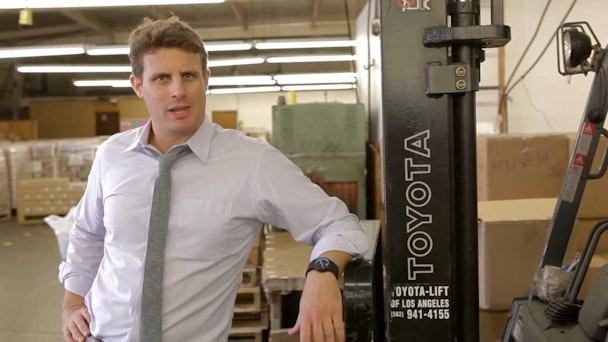With Dollar Shave Club’s razor-thin margins, was Unilever wrong to embrace DTC?
The viral sensation cum direct-to-consumer darling has failed to turn notoriety into sales. We take a look at why.

Dollar Shave Club's 2012 viral launch campaign
When Unilever acquired Dollar Shave Club for $1bn, it was a move that had onlookers abuzz about the potential of the direct-to-consumer distribution model. Seven years on, the challenger razor brand continues to perform below Unilever’s ”expectations”.
The conglomerate said in its Q4 2022 results that Dollar Shave Club, “while marginally profitable, continued to decline in a fiercely competitive market,” adding: ”The performance of Dollar Shave Club has not met our expectations.”
It has since taken an impairment charge on the brand.
Advertisement
What happened to Dollar Shave Club?
In 2016, Unilever brought Dollar Shave Club into its fold, breaching two new sectors. The brand was Unilever’s first razor and its first foray into direct-to-consumer (DTC), serving as a testing ground.
It grew famous after coming to market with a viral launch video featuring its founder, Michael Dubin, which has racked up 27m views since it debuted in 2012. Subsequent marketing campaigns raised Dollar Shave Club’s profile and by 2018 it had 8.5% of the US market share. At the time, marketing courses would point to its campaigns as an example of how to do witty online work, but that fame has diminished in recent years.
To get a feel for the business challenges facing Dollar Shave Club, we spoke to a former rival. Matt Hiscock, who was a brand director at Harry’s, explains that Dollar Shave Club “struck gold with its truly viral launch ad poking fun at the shaving industry”. Its viral marketing drove some sizeable customer acquisition, but Hiscock says that, ultimately, “the bulk of the shaving category remained purchased in stores”.
Harry’s launched shortly after Dollar Shave Club. The rival manufactured its own products so could retain its value proposition. After a few years, Harry’s dropped its pure DTC play and partnered with retailers including Boots, finally appreciating the marketing heft and availability that stores offer.
Advertisement
Hiscock, who is now chief executive officer of DTC vitamin brand Wild Nutrition, says that while shaving is a “highly subscribable” product, grooming products are not. “Dollar Shave Club moved aggressively into men’s grooming products. It will have assumed a lot of people would add these items on to their shave subscription.”
But, he believes, consumers were all too aware that Dollar Shave Club’s £6 shaving gel is far pricier than Boots’ own, which sells as low as £1.60, and even a more premium brand like Bulldog’s, which goes for £3.75. In short, if the plan was to deck out the whole bathroom with cosmetics through Dollar Shave Club, there would have been difficulties from the get-go.
Suggested newsletters for you
What the market thinks about Dollar Shave Club
Brian Wieser, former business analyst at GroupM and now the owner of a consultancy called Madison and Wall, says the market for directly sold razors was always going to be limited. “In luxury, a consumer will go seek out the specific brand, but when it comes to razors or other goods that are more of a commodity, unless you’re radically different not that many people are going to go out of their way.”
With consumer and packaged goods owners all keen to snap up DTCs, such as P&G’s SodaStream buy, Wieser questions if the economics of these new business models are genuinely better than what they were supposed to usurp. “[DTC brands] now have to spend more money on marketing and on physical distribution. And it’s harder to bundle sales of things together.”
But just because the brand is performing below expectations does not mean that Unilever wasted its £1bn. Wieser hypothesizes that Unilever acquired Dollar Shave Club either to bring DTC skills into its empire or as a DTC platform it could use to leverage its other brands. Most likely it was a combination of both.
Despite the DTC model struggling to “take over the world in the categories in which Unilever competes,” Wieser thinks Dollar Shave Club was still a worthy investment. “Is it worth spending a billion dollars for some insurance? What if the world did change in the direction of DTC? Unilever got some learnings out of it and yeah it was expensive, but could it be better off?”
Dollar Shave Club’s failure to grow
There were times when the brand seemed unstoppable as a marketing force and a disruptor. It certainly had rivals worried.
Matt Charlton, the chief executive officer at the ad agency Brothers and Sisters, helped to launch Harry’s in the UK back in 2017 and says that, while working on the account, the agency was waiting for the “big serious Dollar Shave entrance into the UK, knowing that they would say kick us in the nuts, but it never came.”
He added he was “baffled” as to why it didn’t take off in the UK as it is a “seriously interesting challenger brand and could have made life difficult for us”. But even now, all is not lost for Dollar Shave Club, concludes Charlton. “It has a brand packed full of character and tone and Unilever’s resources to activate it. Keep the tone and the attitude, but get the brand upstream and good things can still happen.”

